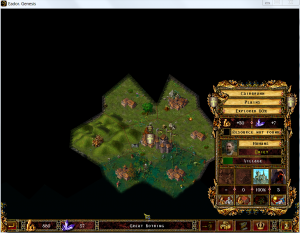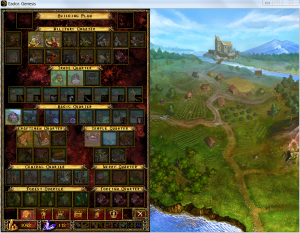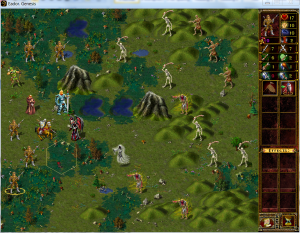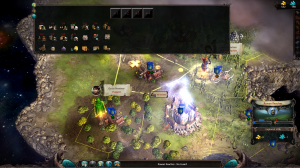
Eador: Genesis is a turn-based fantasy strategy game in the vein of Dominions, Heroes of Might and Magic, and Master of Magic. Originally released back in 2009 as the brainchild of one man, Alexey Bokulev, it was only recently translated into English by publisher Snowbird Games. I’ve been playing the game since last week, and while its graphics and production values are… well, what one would expect from an indie strategy game, its gameplay is pure just-one-more-turnium.
The outline of Genesis will be familiar to genre fans. There is a campaign, which I have not tried; all my matches have been on randomly generated maps. Players start with one province and expand across the map, conquering independent provinces, levelling up heroes, and eventually butting heads with each other in tactical battles. The last one standing wins the game. However, Genesis has several distinctive features:

1. Flowing, micromanagement-light gameplay. I think this is half the secret of Genesis’ addictiveness. Most turn-based strategy games, fantasy or otherwise, require constant fiddling from the player – managing multiple cities’ build queues, pushing numerous armies across the map, etc. By contrast, while Genesis offers plenty of choice – look at all the buildings on that construction screen! – at least on small maps, I only have to deal with a handful of moving parts each turn. Build queues? In Genesis, most construction is done in the capital, a la Imperialism – provincial improvements are relatively bare-bones – and in any case, you can only build one building and one province improvement per turn. As for armies, I’ve never had more than two heroes in play. This means there’s relatively little busywork each turn, and few impediments before it’s time for the next battle.
2. Interesting army composition and tactical battles. Genesis involves a lot of battles, against independents, other players, and the neutrals who guard special sites within provinces. Combat resembles a cross between HOMM (left-to-right hex grids) and Age of Wonders (no unit stacking, heroes participate in the fight). What makes them interesting – and accounts for the remainder of the game’s addictiveness – is the interplay between different unit types, terrain, and positioning on the tactical map, and the resources available to construct an army on the strategic map. For example, there are no fewer than twelve different units available at the basic tier, ranging from swordsmen (slow, tough, and costly for a player without access to iron) to spearmen (jack-of-all-trades light infantry) to barbarians (hard-hitting, lightly armoured brutes). However, you can only unlock four of them per map. So should I pair an archer hero with swordsmen, who can block off incoming enemies, and a healer? Lethal – but expensive. Should I use a warrior plus several spearmen, who can keep up with him as he sprints across the map? The spearmen aren’t likely to survive, but they’re cheap. How will this change if I can get access to iron, or if I can tech up to the next tier of units, or if I unlock the Stoneskin spell?

3. This game is HARD. It took me five tries before I could win! I’ve seen the computer deploy powerful province guards, press its advantage when it has high-level heroes, hit bunched troops with area-of-effect fireballs, and raise skeletons near my squishy rear-line archers/healers. On the default setting, even random events and independents are often brutal. Think an independent province defended by a Cyclops that one-shotted soldiers left and right, or a ghost that just… would… not… be harmed by ordinary weapons.
So is Eador: Genesis, as I’ve seen it hailed, the best fantasy TBS ever made? At this stage – and I stress I’m still learning the game – I would have to say no. Genesis’ setting is typical high fantasy fluff – Dominions 3 beats it hands-down for imagination. As for mechanics, Genesis illustrates that even without micromanagement, a strategy game can still bog down. Upgraded province defences are so powerful that it is painful to fight through an entrenched opponent (it’s much easier to just rush the computer); and the sheer number of battles becomes overwhelming. I tend to autoresolve most battles from the midgame on! Lastly, the game’s difficulty can cross the line from “hard but fair” to “sadistic” – random events, I am looking at you.
Still, while I wouldn’t call Genesis “great” (so far), I do feel comfortable calling it a good, solid strategy game with a number of interesting ideas. In particular, Genesis deserves credit for emphasising “interesting choices” instead of micromanagement – there’s a parallel to Armageddon Empires, another indie TBS that did very well out of avoiding bloat. And those choices are interesting; it’s telling that in all the forum threads I’ve seen, there seems to be no consensus on “the best build order” or “the best units for early expansion”. I lost a match earlier today, and I already want to try again with a different unit mix…

As a final note, next month (April 2013) Genesis is due to receive a remake entitled Eador: Masters of the Broken World. From what I have read, and from what little I have played of the MOTBW beta, the differences between the two are largely cosmetic – MOTBW offers prettier graphics, multiple save slots, and a tweaked campaign – so my comments on Genesis should still apply. While MOTBW’s current beta is visibly a work in progress, I understand a new build is coming soon, so keep an eye out! If Snowbird smooths out MOTBW’s technical issues by launch, it’ll be well worth a look for fantasy TBS fans. Until then – or, knock on wood, in the event that MOTBW doesn’t live up to its promise – Genesis should be a fine, affordable treat.
My preview copy of Eador: Masters of the Broken World was supplied by developer Snowbird Games. However, I paid for my copy of Eador: Genesis out of my pocket.

I’ve been hooked on the Eador: Genesis campaign for the last few weeks. It’s difficult to explain. Most of your time is spent playing randomized maps with the subset of structures that you’ve managed to unlock thus far in the campaign.
The real draw for me is the overarching metagame between battles. There you choose which shard you will assault next, based on the shard’s size, which buildings are unlocked by capturing the shard, how much astral energy it give you, and what perks it unlocks. Astral energy is a metagame resource which you collect each turn from shards you have conquered. You can spend it on temporary perks (such as extra starting equipment in the treasury, extra starting units in the castle garrison, additional gold/gem income and reserves, and prebuilt buildings in your castle) or put it to other, story based uses.
In addition, you can speak to (and negotiate with) rival Masters or your Gremlin assistant to learn about the lore of the world. Apparently there are a number of different endings, though I am weeks into my campaign and have only started to see hints of possible ending paths.
In any case, if they don’t foul up the remake too much, I’ll be picking it up as soon as it is available.
Thanks for the explanation, Teriferin! It’s interesting to hear about the campaign, and it does sound promising. I suspect I would have loved that kind of dynamic experience back when I had more free time. Ah well, c’est la vie…